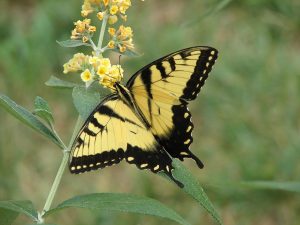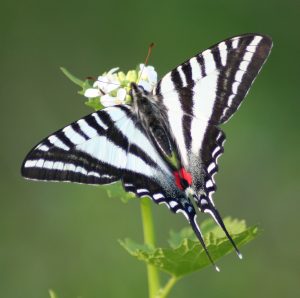Currently, I’m redesigning my eighth of an acre to be more edible and wildlife friendly. So I’m gradually removing the evergreens; replacing them with common (and more exotic) edible perennials and a specially designated flower section for pollinators. In addition to having nectar plants for the adult butterflies, I am also interested in host plants for my “favorite (ephemeral) fliers”. While the Monarch butterfly’s (Danaus plexippus) host plant choices are better known (“All Milkweed, all the time“: Asclepias spp.), other insects also choose to deposit their eggs on specific species.

By Ltshears (Own work) [GFDL (http://www.gnu.org/copyleft/fdl.html) or CC BY-SA 3.0 (http://creativecommons.org/licenses/by-sa/3.0)], via Wikimedia Commons
- White Ash (Fraxinus americana),
- Green Ash (Fraxinus pennsylvanica),
- Black Cherry (Prunus serotina),
- Choke-cherry (Prunus virginiana),
- American Plum (Prunus americana),
- Plum (Prunus domestica),
- Carolina Basswood (Tilia americana),
- Birch (Betula spp.),
- Tulip Tree (Liriodendron tulipifera),
- Sassafras (Sassafras albidum),
- Apple (Malus pumila), and
- Lilac (Syringa vulgaris).
DC’s RiverSmart program provides incentives for residents to establish conservation practices on their property, including rain gardens and shade trees. After having my property surveyed, I was looking forward to a combined host plant and shade tree, since the Tulip tree was on the list of possible tree options.
Alas, the size of my yard meant I needed to have smaller specimens. After consultation, instead of the larger Tulip tree, there are now twin (smaller) Pawpaw (Asimina triloba) trees framing a rain garden. In addition to the hope of edible fruit (soon!); as consolation, the Pawpaw does host *a* swallowtail butterfly’s larvae. The District of Columbia’s (official) insect, the Zebra Swallowtail (Eurytides marcellus) host plant is the Pawpaw. Zebra Swallowtails have the same relationship to Asimina species as the Monarch has to Milkweed. Pawpaw fruits (the largest native fruit indigenous to the Americas) are green in color, custard-like in texture but do not keep well, so they aren’t a commercial grocery item. Since the fruit [seeds and skin are not eaten] and plant are so unusual, many gardeners may not be eager to plant pawpaw thickets (or grafted specimens) in their yard. (These thickets are visible on the C & O Canal’s billy goat trail for interested hikers.)

By Megan McCarty (Own work) [CC BY 3.0 (http://creativecommons.org/licenses/by/3.0)], via Wikimedia Commons
Ramona Winkelbauer is part of the GovLoop Featured Blogger program, where we feature blog posts by government voices from all across the country (and world!). To see more Featured Blogger posts, click here.





Leave a Reply
You must be logged in to post a comment.